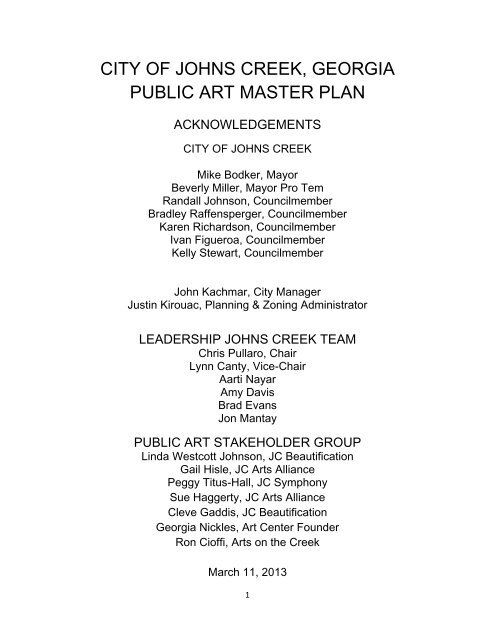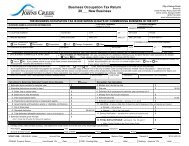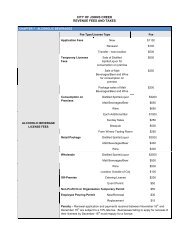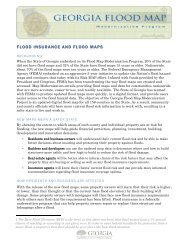City of Johns Creek Public Art Master Plan
City of Johns Creek Public Art Master Plan
City of Johns Creek Public Art Master Plan
You also want an ePaper? Increase the reach of your titles
YUMPU automatically turns print PDFs into web optimized ePapers that Google loves.
CITY OF JOHNS CREEK, GEORGIA<br />
PUBLIC ART MASTER PLAN<br />
ACKNOWLEDGEMENTS<br />
CITY OF JOHNS CREEK<br />
Mike Bodker, Mayor<br />
Beverly Miller, Mayor Pro Tem<br />
Randall <strong>Johns</strong>on, Councilmember<br />
Bradley Raffensperger, Councilmember<br />
Karen Richardson, Councilmember<br />
Ivan Figueroa, Councilmember<br />
Kelly Stewart, Councilmember<br />
John Kachmar, <strong>City</strong> Manager<br />
Justin Kirouac, <strong>Plan</strong>ning & Zoning Administrator<br />
LEADERSHIP JOHNS CREEK TEAM<br />
Chris Pullaro, Chair<br />
Lynn Canty, Vice-Chair<br />
Aarti Nayar<br />
Amy Davis<br />
Brad Evans<br />
Jon Mantay<br />
PUBLIC ART STAKEHOLDER GROUP<br />
Linda Westcott <strong>Johns</strong>on, JC Beautification<br />
Gail Hisle, JC <strong>Art</strong>s Alliance<br />
Peggy Titus-Hall, JC Symphony<br />
Sue Haggerty, JC <strong>Art</strong>s Alliance<br />
Cleve Gaddis, JC Beautification<br />
Georgia Nickles, <strong>Art</strong> Center Founder<br />
Ron Ci<strong>of</strong>fi, <strong>Art</strong>s on the <strong>Creek</strong><br />
March 11, 2013<br />
1
TABLE OF CONTENTS<br />
I. Executive Summary ………………………………………………………………….. .3<br />
II. Introduction & History…………………………………………………………………..4<br />
a. History <strong>of</strong> <strong>Public</strong> <strong>Art</strong><br />
b. History <strong>of</strong> <strong>Public</strong> <strong>Art</strong> in <strong>Johns</strong> <strong>Creek</strong><br />
c. Why <strong>Public</strong> <strong>Art</strong> is Important<br />
i. Vision for <strong>Public</strong> <strong>Art</strong><br />
ii. Shaping the <strong>City</strong><br />
1. Municipal Image<br />
2. Neighborhood Identity<br />
3. Economic Development<br />
d. The Need for a <strong>Plan</strong><br />
III. <strong>Master</strong> <strong>Plan</strong> Development……………………………………………...………………6<br />
IV. Vision, Mission, and Goals....................................................................................8<br />
V. <strong>Public</strong> <strong>Art</strong> Board…………………………………………………………………………8<br />
VI. <strong>Public</strong> <strong>Art</strong> Program – General Standards……………………………….……………9<br />
VII. Scale and Examples <strong>of</strong> <strong>Art</strong>…………………….……………………………………..10<br />
VIII. Funding………………………………………………………………………………....11<br />
IX. Ownership……………………………………………………………………………...11<br />
X. Maintenance…………………………………………………………………………...11<br />
XI. Appendices………………………………………………………………………..…...13<br />
a. <strong>Public</strong> Forum Summary<br />
b. <strong>Public</strong> <strong>Art</strong> Site Locations <strong>Plan</strong><br />
i. Location Maps <strong>of</strong>:<br />
1. Roadway Sites<br />
2. Park Sites<br />
2
Executive Summary<br />
The <strong>City</strong> <strong>of</strong> <strong>Johns</strong> <strong>Creek</strong> was incorporated in 2006 and has a strong foundation <strong>of</strong><br />
culture and arts. Within the <strong>City</strong> many agencies and groups actively promote the arts<br />
including: <strong>Johns</strong> <strong>Creek</strong> Beautification; <strong>Johns</strong> <strong>Creek</strong> <strong>Art</strong> Center; <strong>Johns</strong> <strong>Creek</strong> Symphony;<br />
Performing <strong>Art</strong>s North, Chopin Society, North Atlantic Dance, <strong>Art</strong>s on the <strong>Creek</strong>, and<br />
Autrey Mill Nature Preserve.<br />
As a result <strong>of</strong> the efforts <strong>of</strong> these agencies and others, public art and culture has<br />
become a strong economic engine in the city. To build upon these existing efforts, the<br />
Leadership <strong>Johns</strong> <strong>Creek</strong> (LJC) Class <strong>of</strong> 2013 selected as its project the development <strong>of</strong><br />
a <strong>Public</strong> <strong>Art</strong> Program for the city. As the team researched the topic, it was discovered<br />
that <strong>Public</strong> <strong>Art</strong> was not addressed in the existing <strong>City</strong> Code. The LJC Class learned that<br />
in order to have a public art program, a plan would need to be developed and reviewed<br />
and action taken by the <strong>City</strong> Council in the form <strong>of</strong> an ‘enabling ordinance.’ The LJC<br />
Class gained the permission <strong>of</strong> the <strong>City</strong> Council to pursue this effort. The LJC Team is<br />
proposing to present this plan to the <strong>City</strong> Council at its March 11, 2013 work session for<br />
consideration.<br />
To successfully implement a <strong>Public</strong> <strong>Art</strong> Program in the <strong>City</strong>, the following<br />
recommendations are proposed by the Leadership Class for consideration:<br />
1. Adopt the <strong>Public</strong> <strong>Art</strong> <strong>Master</strong> <strong>Plan</strong> as a companion document to the <strong>City</strong>’s<br />
‘Enabling’ Ordinance.<br />
2. Create a <strong>Public</strong> <strong>Art</strong> Board (PAB) with the responsibility <strong>of</strong> making<br />
recommendations to the <strong>City</strong> Council on <strong>Public</strong> <strong>Art</strong>.<br />
3. Direct the <strong>Public</strong> <strong>Art</strong> Board to develop ‘standards’ for <strong>Public</strong> <strong>Art</strong> and related<br />
criteria for sites and <strong>Public</strong> <strong>Art</strong> pieces.<br />
4. Support the successful implementation <strong>of</strong> the <strong>Public</strong> <strong>Art</strong> <strong>Master</strong> <strong>Plan</strong> on public<br />
property within the <strong>City</strong> and consider allocating some funds for site improvements<br />
in the right-<strong>of</strong>-way and parks, and<br />
5. Require with the approval and placement <strong>of</strong> <strong>Public</strong> <strong>Art</strong> within the <strong>City</strong> an<br />
accompanying plan to address ownership and maintenance <strong>of</strong> the art.<br />
3
Introduction & History<br />
History <strong>of</strong> <strong>Public</strong> <strong>Art</strong><br />
<strong>Public</strong> <strong>Art</strong> has long played an important role in expressing the identity <strong>of</strong> a culture. In<br />
many cases, <strong>Public</strong> <strong>Art</strong> is the legacy by which we remember a culture. <strong>Public</strong> <strong>Art</strong> has<br />
been a part <strong>of</strong> the American landscape since Colonial times, but it wasn’t until the<br />
middle <strong>of</strong> the 20 th century that comprehensive <strong>Public</strong> <strong>Art</strong> programs emerged. After the<br />
establishment <strong>of</strong> the National Endowment for the <strong>Art</strong>s in 1965, the field <strong>of</strong> <strong>Public</strong> <strong>Art</strong><br />
underwent significant change. As more and more cities adopted “percent for art”<br />
ordinances, <strong>Public</strong> <strong>Art</strong> has evolved from a process that placed large-scale versions <strong>of</strong><br />
studio sculpture in unrelated spaces into the broader understanding that art may take<br />
various forms, including being routinely integrated into the surroundings in which it is<br />
placed in, <strong>of</strong>ten becoming part <strong>of</strong> building or structure itself. In cities like Seattle,<br />
Philadelphia, Los Angeles, Miami and others, artists working in the public realm became<br />
more involved in the design <strong>of</strong> public spaces by working closely with architects,<br />
landscape architects and engineers. The result was the use <strong>of</strong> art to shape a new public<br />
space, not just to enhance an existing one. In Seattle, Durango, Phoenix and<br />
Scottsdale, the art went one step further: it has become an integral part <strong>of</strong> civic<br />
infrastructure including, bridges, waste treatment plants, freeways, parks, sports<br />
complexes and other projects.<br />
History <strong>of</strong> <strong>Public</strong> <strong>Art</strong> in <strong>Johns</strong> <strong>Creek</strong><br />
The <strong>City</strong> <strong>of</strong> <strong>Johns</strong> <strong>Creek</strong> is located within the fastest growing metropolitan area in the<br />
U.S. – Metro Atlanta. Close enough to to take advantage <strong>of</strong> Atlanta’s vibrant culture<br />
and economic growth, yet far enough away to experience a quieter lifestyle, <strong>Johns</strong><br />
<strong>Creek</strong> residents enjoy the best <strong>of</strong> both worlds.<br />
<strong>Johns</strong> <strong>Creek</strong> Beautification was formed in 2007 o enhance and preserve the natural<br />
beauty in our common areas and public space through landscaping installations,<br />
environmental preservation, and public works <strong>of</strong> art. When the city was formed, the<br />
Median Beautification Project had begun the “Shock and Ahhh campaign” to create an<br />
oasis-like feel in the medians <strong>of</strong> SR141 as you approach the city limits from the<br />
Chattahoochee River north from Gwinnett County.<br />
From that time, recognition from the <strong>Johns</strong> <strong>Creek</strong> Foundation has allowed <strong>Johns</strong> <strong>Creek</strong><br />
Beautification to partner with the city on state funded grants that require a non-pr<strong>of</strong>it to<br />
commit matching funds in its application. From matching funds the city completed the<br />
median landscape installations on SR141 and a gateway installation. In addition they<br />
were awarded funds from the Foundation to spearhead a feasibility study <strong>of</strong> walking<br />
trails on National Park Service property (Chattahoochee River National Recreation<br />
Area) within the city limits. <strong>Johns</strong> <strong>Creek</strong> Beautification has since developed a<br />
Beautification <strong>Master</strong> <strong>Plan</strong> that targets various projects throughout the city to inspire the<br />
community and restore a sense <strong>of</strong> discovery, vitality and identity <strong>of</strong> the city, while<br />
becoming a visual record <strong>of</strong> the growth <strong>of</strong> the community and its artistic development.<br />
4
The <strong>Johns</strong> <strong>Creek</strong> <strong>Art</strong>s Center (JCAC) was created in 1996 as an independent 501c (3)<br />
community arts organization in the <strong>City</strong> <strong>of</strong> <strong>Johns</strong> <strong>Creek</strong>. Originally called the Ocee <strong>Art</strong>s<br />
Center, it was founded with the purpose <strong>of</strong> bringing arts to a culturally lacking area <strong>of</strong><br />
unincorporated North Fulton County. JCAC has grown to <strong>of</strong>fer a wide selection <strong>of</strong> high<br />
quality art and theatre classes, camps, workshops, and outreach programs to youth and<br />
adult students.<br />
Currently, examples <strong>of</strong> public art existing outside <strong>of</strong> landscaping and environmental<br />
preservation can be found in front <strong>of</strong> the <strong>Johns</strong> <strong>Creek</strong> Design Center, and in a<br />
contributing mosaic bench in Tech Park donated by the Leadership <strong>Johns</strong> <strong>Creek</strong> Class<br />
<strong>of</strong> 2011.<br />
Why is <strong>Public</strong> <strong>Art</strong> Important?<br />
Vision for <strong>Public</strong> <strong>Art</strong> - <strong>Public</strong> <strong>Art</strong> in <strong>Johns</strong> <strong>Creek</strong> will add to the visual identity <strong>of</strong> the<br />
<strong>City</strong>, creating memorable images <strong>of</strong> the <strong>City</strong> for visitors and residents alike. <strong>Public</strong> <strong>Art</strong><br />
will reflect on <strong>Johns</strong> <strong>Creek</strong>’s role as an emerging regional leader in culture and<br />
recreation, and it will support the <strong>City</strong>’s development as a visually attractive place to<br />
live, learn, work and play.<br />
Shaping the <strong>City</strong> - <strong>Public</strong> <strong>Art</strong> can contribute to the <strong>City</strong>’s visual identity in three basic<br />
ways. Some art projects will contribute to <strong>Johns</strong> <strong>Creek</strong>’s MUNICIPAL IMAGE as<br />
perceived by outsiders, reinforcing the city’s role as a desirable place to live as well as<br />
to locate a business. Some projects will support individual NEIGHBORHOOD IDENTITY<br />
by creating local points <strong>of</strong> pride. And some projects will promote ECONOMIC<br />
DEVELOPMENT by attracting visitors and raising the <strong>City</strong>’s visibility.<br />
1. MUNICIPAL IMAGE is the mental picture <strong>of</strong> a city based on the features we<br />
most associate with it. This image can be driven by a concerted effort by the city<br />
or it may take its own course through a total lack <strong>of</strong> interest. It can be influenced<br />
by a single prominent landmark or riven by a collection <strong>of</strong> smaller attributes.<br />
While we typically think <strong>of</strong> an image as frozen in time, a municipal image can<br />
portray the story <strong>of</strong> what is happening within the city, the direction the city is<br />
moving, and the interests the leaders and citizens have in their city’s history and<br />
future.<br />
We live in a society that places great value on ratings and rankings. In assessing<br />
one city against another, the enterprises responsible for those ratings are<br />
influenced by a city’s municipal image. Therefore, it is vitally important to a city’s<br />
future welfare that it identifies what it hopes to become, actively promotes a<br />
municipal image that captures its desired future state, and then strives to achieve<br />
that state through its decisions and actions. After all, the attractiveness <strong>of</strong> a city<br />
may lie in its position within those rankings or its movement upward through<br />
those rankings. But whether already at the top or only aspiring to be there, a<br />
municipal image that portrays a city as a place where people would want to come<br />
5
to visit, shop, and live will play a significant role in helping that city thrive and<br />
grow.<br />
<strong>Public</strong> <strong>Art</strong> can play a major role in creating and enhancing a city’s municipal<br />
image. The presence <strong>of</strong> <strong>Public</strong> <strong>Art</strong> delivers a message that the arts are important<br />
to the leaders and the people <strong>of</strong> the city. The belief that art is appreciated within<br />
the city attracts both the creators and consumers <strong>of</strong> the arts. As more people<br />
come to the city to take part (as creators, consumers, or both), both the quality<br />
and the abundance <strong>of</strong> art increase, bringing more art to additional venues and<br />
further enhancing the appeal <strong>of</strong> the city. To ensure that the process does not<br />
spiral out <strong>of</strong> control, it is critical that <strong>Public</strong> <strong>Art</strong> is thoughtfully commissioned,<br />
planned, and presented. If well managed, <strong>Public</strong> <strong>Art</strong> can be one <strong>of</strong> the most<br />
prominent factors in creating a municipal image and in fulfilling that image for<br />
people who come to see the city for themselves.<br />
2. NEIGHBORHOOD IDENTITY is important as locations are identified for pieces <strong>of</strong><br />
<strong>Public</strong> <strong>Art</strong>. In the 1970’s, the concept <strong>of</strong> “plop art” generated lots <strong>of</strong> sculptures<br />
placed in plazas and parks with little planning or thought as to the relationship<br />
between the art and its location. More recent <strong>Public</strong> <strong>Art</strong> programs have sought to<br />
integrate art into the architecture and landscape to foster a greater sense <strong>of</strong><br />
place. These locations over time become identified not by the more traditional<br />
monikers but by the pieces <strong>of</strong> <strong>Public</strong> <strong>Art</strong> in the area. Examples include<br />
Greenwich Village, Soho, Atlantic Station, etc. In these areas, <strong>Public</strong> <strong>Art</strong> has<br />
become the visual identity <strong>of</strong> the neighborhood<br />
3. ECONOMIC DEVELOPMENT is a primary component to fostering the<br />
development <strong>of</strong> intrinsically strong cities. Creating a <strong>Public</strong> <strong>Art</strong> Program in <strong>Johns</strong><br />
<strong>Creek</strong> can have a positive economic impact on our community. In addition to<br />
establishing a sense <strong>of</strong> identity and providing the community with an opportunity<br />
to experience art, <strong>Public</strong> <strong>Art</strong> projects draw attention to the city. The economic<br />
impact <strong>of</strong> <strong>Public</strong> <strong>Art</strong> is apparent in these three examples:<br />
1. The “Trail Drive” in Dallas has become the 2nd most visited tourist<br />
attraction topped only by Dealy Plaza.<br />
2. The “Cows in Parade” in Chicago generated over $200 million in<br />
additional business revenues for the city in just a few months.<br />
3. Christo’s “Wrapped Reichstag” in Berlin generated $300 million in just<br />
three weeks compared to theaters and museums; <strong>Public</strong> <strong>Art</strong> has<br />
relatively low overhead, low staffing costs, and produces less waste or<br />
environmental damage.<br />
Economic Value in a Community - Increasingly, residents, business owners,<br />
and community leaders recognize that the arts, and specifically <strong>Public</strong> <strong>Art</strong>,<br />
contribute to economic development. On the larger scale, art sites and arts<br />
institutions attract business, new residents and tourists. On any scale, wellexecuted<br />
<strong>Public</strong> <strong>Art</strong> can create a sense <strong>of</strong> place, a focal point and a destination.<br />
6
This unique definition <strong>of</strong> place is manifest in two dimensions: the physical design<br />
<strong>of</strong> civic space, and the social/emotional benefit. Good public art supports local<br />
identity, complementing and reflecting the individual character <strong>of</strong> a neighborhood,<br />
a community or a city. Even the process <strong>of</strong> conceiving a project and selecting an<br />
artist or art proposal is an opportunity for deeper engagement by the members <strong>of</strong><br />
the community. The resulting artwork can be a tremendous source <strong>of</strong> civic and<br />
neighborhood pride, encouraging local “ownership” in the built environment and<br />
having a salutary effect on many aspects <strong>of</strong> civic life, including public safety.<br />
The cultural well-being <strong>of</strong> a community is as important as the aspects <strong>of</strong><br />
infrastructure and public welfare. While some citizens struggle with this charge,<br />
many communities are finding it increasingly necessary to encourage and<br />
maintain cultural infrastructure as a viable and marketable asset. Many cities<br />
have an array <strong>of</strong> scheduled municipal events; others support educational and/or<br />
recreational opportunities for their citizens, <strong>of</strong>ten under the auspices <strong>of</strong> a parks<br />
and recreation department.<br />
The Need for a <strong>Plan</strong><br />
Proactive planning is essential to the implementation <strong>of</strong> a strong and enduring <strong>Public</strong> <strong>Art</strong><br />
Program that will help shape <strong>Johns</strong> <strong>Creek</strong>’s appearance and character. Throughout the<br />
United States, the most progressive and forward-thinking cities are crafting plans for<br />
expending and administering funds for art in public places with vision and responsibility.<br />
The following plan is designed to begin the implementation <strong>of</strong> a <strong>Public</strong> <strong>Art</strong> program in<br />
<strong>Johns</strong> <strong>Creek</strong>. The best position is to proactively create a <strong>Public</strong> <strong>Art</strong> “roadmap” with<br />
planned uses for key sites and established priorities that reflect our particular<br />
community. It is also important that one board working on behalf <strong>of</strong> local government<br />
has the vision and expertise to oversee all art and design elements in the public domain<br />
(i.e., accessible in or visible from public space).<br />
The <strong>City</strong> <strong>of</strong> <strong>Johns</strong> <strong>Creek</strong> needs and deserves a proactive vision for public art, a<br />
thoughtful curatorial perspective that can complement other planning processes and<br />
efforts, and in some cases lead the way for civic development and improvements.<br />
<strong>Master</strong> <strong>Plan</strong> Development<br />
Overview <strong>of</strong> Process<br />
On November 8, , 2013, Leadership <strong>Johns</strong> <strong>Creek</strong> hosted a “Non-Pr<strong>of</strong>it Expo” for LJC<br />
class members to meet with local non-pr<strong>of</strong>its in order to learn more about the<br />
organizations, form relationships and advocate for non-pr<strong>of</strong>its in the community.<br />
Meeting with <strong>Johns</strong> <strong>Creek</strong> Beautification and understanding their aim <strong>of</strong> preservation<br />
and beautification <strong>of</strong> <strong>Johns</strong> <strong>Creek</strong> helped provide the inspiration for installation <strong>of</strong> public<br />
art in the community. However, it was difficult to identify a clear pathway forward which<br />
enabled the installation <strong>of</strong> <strong>Public</strong> <strong>Art</strong>. Thus, the LJC Class elected to explore the<br />
creation <strong>of</strong> a <strong>Public</strong> <strong>Art</strong> <strong>Master</strong> <strong>Plan</strong>.<br />
7
<strong>Master</strong> <strong>Plan</strong><br />
This is a document that encompasses both the long-term vision <strong>of</strong> arts for the city and<br />
the practical steps that both the city and the community need to take in order to achieve<br />
that vision. Specifically it seeks to ask the questions <strong>of</strong> how arts relate to the <strong>City</strong> <strong>of</strong><br />
<strong>Johns</strong> <strong>Creek</strong> both in esthetic and economic impact on the community, establish<br />
procedures for site and art selection and funding, and the setting up <strong>of</strong> relevant<br />
administrative processes to enable the long term sustenance and growth <strong>of</strong> such an<br />
undertaking.<br />
The development process involved four main steps: LJC Class research, public forums,<br />
stakeholder deliberations, and feedback from city staff.<br />
Research<br />
This involved a comprehensive needs assessment and evaluation <strong>of</strong> <strong>Public</strong> <strong>Art</strong><br />
installation in the <strong>City</strong> <strong>of</strong> <strong>Johns</strong> <strong>Creek</strong> as well a study <strong>of</strong> similar projects undertaken by<br />
various cities across the country. Additionally a similar process was followed for the<br />
purpose <strong>of</strong> understanding the various art forms with an eye to installing one such art<br />
piece in the public realm.<br />
<strong>Public</strong> Forums<br />
To gather the opinions regarding public art in the city <strong>of</strong> <strong>Johns</strong> <strong>Creek</strong>, a series <strong>of</strong> two<br />
public forums were held at Emory <strong>Johns</strong> <strong>Creek</strong> Hospital and Newtown Park Community<br />
Center on:<br />
a. January 30, 2013<br />
b. January 31, 2013<br />
Many <strong>of</strong> the ideas for the role <strong>of</strong> <strong>Public</strong> <strong>Art</strong> in the <strong>City</strong> <strong>of</strong> <strong>Johns</strong> <strong>Creek</strong> came directly from<br />
these public forums. The discussion included: a review <strong>of</strong> various <strong>Public</strong> <strong>Art</strong> master<br />
plans from around the country; visual preference surveys for types and styles <strong>of</strong> <strong>Public</strong><br />
<strong>Art</strong>; identification <strong>of</strong> preferred locations for <strong>Public</strong> <strong>Art</strong> in both roadways areas and parks<br />
(the location for possible public art pieces commenced with an initial effort prepared by<br />
<strong>Johns</strong> <strong>Creek</strong> Beautification and was expanded upon by citizens at the public forum);<br />
question and answer section on the size and structure <strong>of</strong> the <strong>Public</strong> <strong>Art</strong> Board; and a<br />
survey on <strong>Public</strong> <strong>Art</strong>.<br />
Community Survey<br />
The Leadership Class developed and advertised a survey on <strong>Public</strong> <strong>Art</strong> to gain a larger<br />
response from the community on their perspective <strong>of</strong> <strong>Public</strong> <strong>Art</strong>. The total number <strong>of</strong><br />
surveys received exceeded 100.<br />
<strong>Public</strong> <strong>Art</strong> Discussions with Stakeholders and Interested Citizens<br />
After preparing the initial draft <strong>of</strong> the <strong>Public</strong> <strong>Art</strong> <strong>Master</strong> <strong>Plan</strong>, the LJC Class<br />
presented its draft on:<br />
c. February 8, , 2013 - to stakeholders and community members at the<br />
Chamber <strong>of</strong> Commerce <strong>of</strong>fice.<br />
8
d. February 25, 2013 – to the community by posting the document on the<br />
<strong>City</strong>’s webpage for comment period.<br />
e. February 27,2013 – to community members at the <strong>Johns</strong> <strong>Creek</strong> <strong>Art</strong>s<br />
Center, Participation and Feedback from <strong>City</strong> Staff.<br />
The <strong>City</strong> staff was very important in the development <strong>of</strong> the master plan beginning<br />
with a preliminary meeting in November with <strong>City</strong> Manager John Kachmar, Patty<br />
Hansen, and Justin Kirouac. Additional staff members were consulted after the<br />
public forums to review the location identified by residents as potential <strong>Public</strong> <strong>Art</strong><br />
sites including: <strong>Public</strong> Works Director, Community Development Director, <strong>City</strong><br />
Engineer, and Parks Director.<br />
Final <strong>Public</strong> <strong>Art</strong> <strong>Master</strong> <strong>Plan</strong><br />
The final <strong>Public</strong> <strong>Art</strong> <strong>Master</strong> <strong>Plan</strong> includes additional feedback received during the<br />
public comment period February 25 th through March 5, 2013<br />
Vision, Mission, and Goals<br />
Vision - The <strong>Public</strong> <strong>Art</strong> Program will enhance the image <strong>of</strong> <strong>Johns</strong> <strong>Creek</strong> and foster a<br />
“sense <strong>of</strong> place” for its residents and visitors.<br />
Mission - The mission <strong>of</strong> the <strong>Johns</strong> <strong>Creek</strong> <strong>Public</strong> <strong>Art</strong> Program is to create a more<br />
visually pleasing environment and to expand the opportunities for residents and visitors<br />
to experience quality works <strong>of</strong> art.<br />
Goals - The goals <strong>of</strong> the <strong>Public</strong> <strong>Art</strong> Program are:<br />
1) Create a stimulating cultural environment by:<br />
i) Promoting the aesthetic values <strong>of</strong> the entire community,<br />
ii) Providing opportunity to enjoy and appreciate works <strong>of</strong> art,<br />
iii) Reflecting and enhancing the <strong>City</strong>’s:<br />
(1) Heritage<br />
(2) Diversity<br />
(3) Character<br />
iv) Integrating public artworks into the architecture, infrastructure and landscape,<br />
and<br />
v) Encouraging the preservation and protection <strong>of</strong> works <strong>of</strong> art.<br />
2) Assist in the creation <strong>of</strong> superior and diverse aesthetic character <strong>of</strong> the <strong>City</strong>’s built<br />
environment that is:<br />
i) Vital to the quality <strong>of</strong> the life <strong>of</strong> its citizens,<br />
ii) Vital to the economic success <strong>of</strong> its businesses,<br />
iii) An attraction for visitors, and<br />
iv) Supportive <strong>of</strong> the <strong>City</strong>’s mission to make <strong>Johns</strong> <strong>Creek</strong> "the premier <strong>City</strong> in<br />
which to live, work and raise a family.”<br />
3) Impact the quality <strong>of</strong> life in our community by fostering:<br />
9
i) advocacy,<br />
ii) marketing,<br />
iii) education, and<br />
iv) Stewardship <strong>of</strong> public art that will create public understanding <strong>of</strong> the social<br />
and economic value <strong>of</strong> <strong>Public</strong> <strong>Art</strong> in the community.<br />
<strong>Public</strong> <strong>Art</strong> Board (PAB)<br />
A <strong>Public</strong> <strong>Art</strong> Board (PAB) should be established to advise the <strong>Johns</strong> <strong>Creek</strong> <strong>City</strong> Council<br />
as to matters concerning the selection, placement, maintenance, and removal <strong>of</strong> <strong>Public</strong><br />
<strong>Art</strong>. The five (5) member <strong>Public</strong> <strong>Art</strong> Board should be appointed and overseen by the<br />
<strong>City</strong> Council. To support the PAB in their efforts, we propose the creation <strong>of</strong> Community<br />
Outreach Panels (COP) to serve as ad-hoc committees representing each <strong>of</strong> the major<br />
<strong>Public</strong> <strong>Art</strong> disciplines including:<br />
A. Sculptures,<br />
B. Murals,<br />
C. Mosaics, and<br />
D. Miscellaneous<br />
A Community Outreach Panel will be chaired by a PAB member and will be comprised<br />
<strong>of</strong> four additional members who are residents <strong>of</strong> the <strong>Johns</strong> <strong>Creek</strong> area where a<br />
proposed piece <strong>of</strong> <strong>Public</strong> <strong>Art</strong> is planned. The purpose <strong>of</strong> these panels is to keep the<br />
community informed and gather feedback about the particular piece <strong>of</strong> art being<br />
considered, its artist, theme, medium, length <strong>of</strong> display, and subject matter content.<br />
The Community Outreach Panel will make recommendations to the PAB.<br />
The PAB is proposed to be a dependent Advisory Board appointed by the <strong>City</strong> Council.<br />
The PAB will make recommendations to the <strong>City</strong> Council who will make the final<br />
determination on each piece <strong>of</strong> <strong>Public</strong> <strong>Art</strong>.<br />
<strong>Public</strong> <strong>Art</strong> Program – General Standards<br />
General Standards - By combining the volunteer efforts <strong>of</strong> citizens like those serving in<br />
the Leadership Class along with those serving in the <strong>Art</strong>s Community, and building upon<br />
the previous efforts <strong>of</strong> <strong>Johns</strong> <strong>Creek</strong> Beautification, <strong>Johns</strong> <strong>Creek</strong> will be prepared to<br />
create a world-class public art community. The <strong>City</strong> Council intends for all <strong>Public</strong> <strong>Art</strong><br />
within the corporate limits <strong>of</strong> the <strong>City</strong> be selected and approved according to the <strong>Public</strong><br />
<strong>Art</strong> <strong>Master</strong> <strong>Plan</strong> and Enabling Ordinance.<br />
Acquisition Standards<br />
<strong>Public</strong> <strong>Art</strong> is defined as the work <strong>of</strong> a visual artist located on public property in a publicly<br />
accessible space. <strong>Public</strong> <strong>Art</strong> includes, but is not limited to, paintings, murals, statues,<br />
stained glass, fiber art, relief or other sculpture, fountains, arches and other structures<br />
intended for ornament or commemoration, carvings, frescoes, mosaics, mobiles,<br />
photographs, drawings, collages, prints, landscape art, and crafts, both decorative and<br />
10
utilitarian. <strong>Public</strong> <strong>Art</strong> may be temporary or permanent in nature. <strong>Public</strong> <strong>Art</strong> projects may<br />
also include visual or landscape artists serving on design and development teams to<br />
identify opportunities and approaches for incorporating artwork or aesthetic concepts<br />
into <strong>City</strong> building and visible public improvement projects. Regardless <strong>of</strong> the method <strong>of</strong><br />
acquisition, certain fundamental criteria will be universally applied to any work <strong>of</strong> art<br />
under consideration including:<br />
A. <strong>Art</strong>istic merit.<br />
B. Physical condition <strong>of</strong> the artwork.<br />
C. History and provenance <strong>of</strong> the artwork.<br />
D. Compatibility with the <strong>City</strong>’s <strong>Public</strong> <strong>Art</strong> program and collection.<br />
E. Availability <strong>of</strong> an appropriate location for siting on public property.<br />
F. Requirements for installation, storage, and maintenance.<br />
G. Liability considerations and issues <strong>of</strong> public safety.<br />
Acceptable <strong>Art</strong>. Acceptable forms <strong>of</strong> art (“Acceptable <strong>Art</strong>”) shall include but are not<br />
necessarily limited to, the following:<br />
A. All forms <strong>of</strong> limited edition or one-<strong>of</strong>-a-kind original creations <strong>of</strong> visual art created<br />
by an artist.<br />
B. Project features and enhancements which are unique and produced by a<br />
pr<strong>of</strong>essional artist such as benches and fountains.<br />
C. Murals or mosaics covering walls.<br />
D. Natural <strong>Art</strong> work.<br />
E. Pr<strong>of</strong>essional artist sculptures which can be freestanding, wall-supported or<br />
suspended and made <strong>of</strong> durable materials suitable to the site and the climate.<br />
F. Other suitable artworks as presented in a catalogue and previously approved by<br />
the <strong>City</strong> Council.<br />
Not Acceptable <strong>Art</strong>. The following, non-exclusive list describes those items not<br />
considered Acceptable <strong>Art</strong>:<br />
A. Business logos or art that incorporates a logo for the primary purpose <strong>of</strong><br />
advertising a business.<br />
B. Directional elements such as super-graphics, signage or color coding except<br />
where these elements are integral parts <strong>of</strong> the original works <strong>of</strong> art.<br />
C. Mass-produced art objects, such as fountains, statuary objects, or playground<br />
equipment.<br />
D. Reproduction by mechanical or other means <strong>of</strong> original works <strong>of</strong> art.<br />
E. Decorative ornamental or functional elements created by the project architect<br />
instead <strong>of</strong> an artist commissioned for this purpose<br />
F. Electrical, water or mechanical service for activation <strong>of</strong> the works <strong>of</strong> art,<br />
G. <strong>Art</strong> exhibitions and educational activities.<br />
H. Security and publicity concerning works <strong>of</strong> art.<br />
I. <strong>Art</strong> used as signage.<br />
Scale and Examples <strong>of</strong> <strong>Art</strong><br />
11
Recommended types <strong>of</strong> <strong>Public</strong> <strong>Art</strong> are described in terms <strong>of</strong> the proportion/impact <strong>of</strong> the<br />
artwork using the terms large-scale, medium-scale and small-scale.<br />
Large-scale art is prominent, has a significant impact due to its size and has the<br />
ability to change a location. Large-scale art works are easily viewed from a distance<br />
and impact the surrounding area. A large-scale work can be an independent<br />
sculpture, it may include several components, or it may be an artwork integrated into<br />
a large building, open space, or park.<br />
Medium-scale is on a human-size scale. Medium-scale art may be visible from a<br />
distance although it has greater impact and is better viewed at the pedestrian level.<br />
The art could be a focal point or a built-in feature.<br />
Small-scale art requires close proximity on the part <strong>of</strong> the viewer in order to have an<br />
impact. Some examples <strong>of</strong> small-scale public art include surface treatments,<br />
sidewalk inlays or functional pieces such as benches and planters.<br />
This <strong>Master</strong> <strong>Plan</strong> focuses solely on pieces <strong>of</strong> art placed on public property. The location<br />
<strong>of</strong> the art will dictate the criteria and scale for the piece. For example, <strong>Public</strong> <strong>Art</strong> placed<br />
in city rights-<strong>of</strong>-ways and easements will be required to meet all Federal and State<br />
Traffic Management Regulations/Guidelines, as applicable. For pieces <strong>of</strong> art placed in<br />
parks, the criteria above will be used. The <strong>Public</strong> <strong>Art</strong> Board may develop these criteria<br />
further.<br />
Funding<br />
There are many ways to fund a <strong>Public</strong> <strong>Art</strong> Program in <strong>Johns</strong> <strong>Creek</strong> ranging from a<br />
percent-for-art program, grants-in-aid from philanthropic groups and governments,<br />
corporate contributions and private donations. The goal should be to create a funding<br />
plan which accomplishes the goals and objectives <strong>of</strong> the plan. Various options for<br />
consideration over the life <strong>of</strong> this program include:<br />
A. Percent-For-<strong>Art</strong> Program - This funding is traditionally viewed as the backbone <strong>of</strong><br />
a successful <strong>Public</strong> <strong>Art</strong> Program. In some cities, 1% <strong>of</strong> the Capital Improvement<br />
Program budget is allocated to a fund providing for acquisition, placement,<br />
maintenance, advocacy and education.<br />
B. Start-Up Funds – Some municipalities provide start-up funds to initiate projects<br />
similar to those presented in the Appendices. The allocation <strong>of</strong> resources may<br />
fulfill the goals <strong>of</strong> the program on a faster timeline.<br />
C. Partner with a Foundation - A 501(c) (3) nonpr<strong>of</strong>it corporation may be identified<br />
to accept donations from community businesses, organizations, and individuals<br />
interested in contributing to <strong>Public</strong> <strong>Art</strong> for community enrichment. Collaborations<br />
with individuals, organizations, or businesses are important to gaining and<br />
maintaining community involvement and support.<br />
Ownership<br />
Responsibility after Installation<br />
<strong>Public</strong> <strong>Art</strong> located on <strong>City</strong>-owned property which are permanent shall be dedicated to<br />
the <strong>City</strong>. The art’s final location will be reviewed and approved by both the <strong>City</strong>’s <strong>Public</strong><br />
Works Director and Community Development Director or designees to ensure<br />
compliance with the ADA and other applicable codes, and to minimize conflicts with<br />
12
public utilities in <strong>City</strong> rights-<strong>of</strong>-way/parks. The <strong>City</strong> will insure and maintain all pieces on<br />
<strong>City</strong>-owned property or rely on the plan presented by the PAB.<br />
Maintenance<br />
As part <strong>of</strong> the <strong>Public</strong> <strong>Art</strong> commissioning process, the PAB will develop and recommend<br />
to the <strong>City</strong> Council a plan to maintain each piece <strong>of</strong> <strong>Public</strong> <strong>Art</strong>. This plan will include, at<br />
a minimum, who will be responsible for the maintenance <strong>of</strong> the art piece, specific steps<br />
to maintain the piece, removal plans should this be required, and any other conditions<br />
as deemed necessary.<br />
PUBLIC ART PROJECTS<br />
<strong>Public</strong> <strong>Art</strong> projects may only be initiated by the PAB or through a request submitted by a<br />
<strong>Johns</strong> <strong>Creek</strong> based not-for-pr<strong>of</strong>it organization to the PAB. Each request will include an<br />
overall art plan addressing location, style, ownership, responsibility for the maintenance<br />
and conservation <strong>of</strong> the <strong>Public</strong> <strong>Art</strong>. The PAB will create a COP to review the request<br />
and provide a recommendation to the PAB for approval/disapproval.<br />
Appendices<br />
Potential <strong>Public</strong> <strong>Art</strong> Sites<br />
As identified by Citizens at the <strong>Public</strong> Forums<br />
13
Potential <strong>Public</strong> <strong>Art</strong> Sites<br />
As Reviewed and Recommended by LJC Class based on Consultation<br />
with <strong>City</strong> Staff<br />
15
Potential <strong>Public</strong> <strong>Art</strong> Sites<br />
At <strong>City</strong> Parks<br />
17














